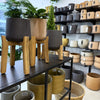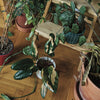Autumn is here and what to do with indoor plants?

As usual, with the arrival of autumn comes changes in the conditions of care for houseplants. Proper preparation helps them survive the colder period in winter and keep them in good condition. In autumn, the "days get shorter", which means that the plants will have a few hours less light and the daily temperature will also start to decrease. Let's take a look at what we should do with plants in autumn.
Preventive plant maintenance
From spring to summer, your plants grew beautifully, bloomed, multiplied, and with the arrival of autumn, we can observe increased leaf fall, yellowing, the appearance of pests, and other ailments in many houseplants. In the period from September to October, it is a good idea to properly inspect the houseplants in the whole household for pests , in winter the immunity of plants is always lower than in summer, and pests have an easier time killing your plant. On that occasion, cut off the yellowed leaves on all plants, which uselessly take away energy from the plant, and if you have houseplants that are still blooming, be sure to remove the rest of the flowers after they have finished blooming, which would also take away energy from the plant. If you have had to deal with the infestation of the whole apartment by some pest, such as the almost invisible weevils or thrips, you probably won't do anything wrong if you treat all plants with a preparation against sucking insects.
It seems to you that you need to repot the plant, but it seems to you that it is already too late to repot? During September and October, if it is not too cold and you do not have plants in a cold environment, you can still transplant the plants at the last minute. However, it should be borne in mind that it is generally not recommended to transplant plants if the room temperature drops below a certain threshold and the plant begins to go into an almost winter sleep. Of course, this does not apply to all houseplants and it depends a lot on what kind of plants they are, where you place them and also how big they are.

Dressing
In autumn, it is important to reduce the amount of water that the plants receive. The days are shorter and fewer hours of sunshine means less water evaporation from the soil. Adjust watering according to the specific needs of individual plants. Let the top of the substrate dry a little before watering again. For plants that you know do not absorb as much water, significantly extend the time for the next watering, overwatering plants is often fatal and leads to the death of the plant. If you have been watering with fresh cold tap water until now, stop and let the water stand for 1-2 days so that unnecessary minerals such as chlorine evaporate from it, and also do not use ice water. Room temperature water is certainly acceptable for plants.
Temperature and air humidity
Indoor plants can react sensitively to the drop in temperatures in the autumn and winter months. Make sure they are in a room where the temperature will not drop below their minimum recommended limit. The air in heated homes can be dry, so consider using a humidifier or placing plants on saucers of water and pebbles to increase the humidity around them.
In the autumn months, you also have to watch out for drafts, it will be colder at night and in the mornings as well as during the day. An open window that will blow on plants that may not be able to handle a draft colder than the temperature in the apartment and will repay you with falling leaves or yellowing.
Fertilization
In autumn, plant growth slows down, so it is not necessary to add a high-nitrogen fertilizer . Instead, choose a fertilizer with a higher phosphorus and potassium content, which supports the root system and prepares the plants for the dormant period. Apply fertilizer in half to a third of the usual amount.
If you want to stop using fertilizers completely, but you want to give the plants at least a little something to eat, you can choose, for example, lignohumate, which especially supports the root system of plants and is recommended to be used especially through winter until spring, before you replace it with fertilizers again. An overdose of fertilizer, even in a small amount in the cold months, can also be a disaster for the plant, the plant takes in much less nutrients and excess substances from fertilizers can cause root rot and the plant will show this again very quickly.
Plant migration
The beginning of autumn is a good time for a small migration in your home. If you have plants that you know grow well from spring to summer on the south side of the apartment near the sun, but do not do well in the same place during the winter, move such plants elsewhere. If it is not a species that can be fatally sensitive to a change of habitat, the plant may benefit from it.
A good example can be e.g. a variegated plant , which was used to sunlight for at least a few hours a day on the south windowsill for half a year, and with the arrival of autumn, the sun no longer reaches the windows on this side, but the time the sun shines on the northwest windowsill gradually increases .
Remember that each plant may have specific needs, so it's important to watch for any sign of stress or a problem. With more sensitive plants, it may be advisable to make most changes gradually to avoid shock. Proper care of houseplants in autumn will guarantee that they will bloom beautifully and thrive even in the colder months.




